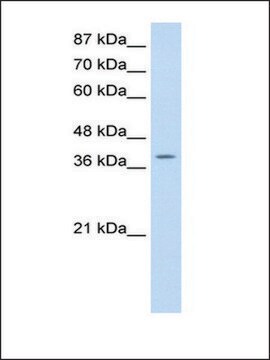05-807
Anti-phospho-CREB (Ser133) Antibody, clone 634-2
clone 634-2, Upstate®, from mouse
Sinónimos:
active transcription factor CREB, cAMP responsive element binding protein 1, cAMP-response element-binding protein-1, transactivator protein
About This Item
Productos recomendados
biological source
mouse
Quality Level
antibody form
purified antibody
antibody product type
primary antibodies
clone
634-2, monoclonal
species reactivity
rat, mouse
manufacturer/tradename
Upstate®
technique(s)
immunocytochemistry: suitable
immunofluorescence: suitable
western blot: suitable
isotype
IgG1κ
NCBI accession no.
UniProt accession no.
shipped in
dry ice
target post-translational modification
phosphorylation (pSer133)
Gene Information
human ... CREB1(1385)
General description
Specificity
Immunogen
Application
1:500 to 1:32,000 dilutions of this lot detected CREB peptide containing phosphoserine 133. The antibody did NOT recognize the nonphosphorylated peptide of the same sequence
Immunofluorescence / Immunocytochemistry:
This antibody has been reported by an independent laboratory to detect phospho-CREB (Ser133) using immunofluorescence.
Epigenetics & Nuclear Function
Transcription Factors
Quality
Western Blot Analysis:
A 1:1,000 to 1:4,000 dilution of this lot detected phospho-CREB (Ser 133) in RIPA lysates from forskolin treated rat PC-12 and mouse 3T3/A31 cells (Figure A).
Target description
Physical form
Storage and Stability
Analysis Note
Human breast carcinoma, forskolin- and FGF-treated SK-N-MC cell extracts.
Other Notes
Legal Information
Disclaimer
Not finding the right product?
Try our Herramienta de selección de productos.
Optional
Storage Class
10 - Combustible liquids
wgk_germany
WGK 1
Certificados de análisis (COA)
Busque Certificados de análisis (COA) introduciendo el número de lote del producto. Los números de lote se encuentran en la etiqueta del producto después de las palabras «Lot» o «Batch»
¿Ya tiene este producto?
Encuentre la documentación para los productos que ha comprado recientemente en la Biblioteca de documentos.
Nuestro equipo de científicos tiene experiencia en todas las áreas de investigación: Ciencias de la vida, Ciencia de los materiales, Síntesis química, Cromatografía, Analítica y muchas otras.
Póngase en contacto con el Servicio técnico








